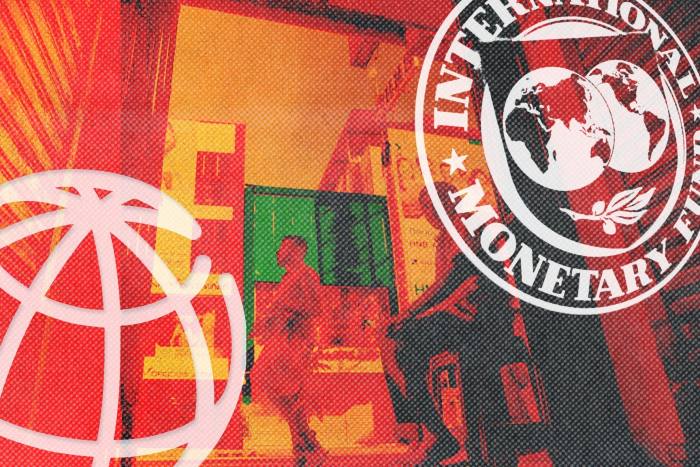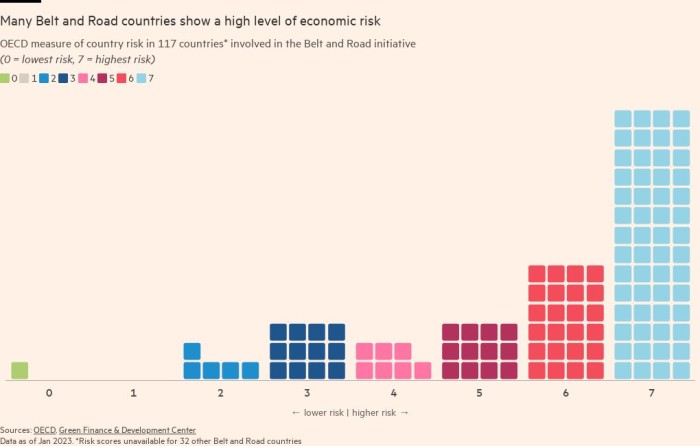[ad_1]
China’s $1tn Belt and Road Initiative infrastructure finance programme has been hit by spiralling bad loans, with more than $78bn-worth of borrowing turning sour over the past three years.
The scheme made China the world’s largest bilateral creditor, but the figures suggest it has become a financial millstone for Beijing and its biggest banks.
About $78.5bn of loans from Chinese institutions to roads, railways, ports, airports and other infrastructure around the world were renegotiated or written off between 2020 and the end of March this year, according to figures compiled by New York-based research organisation the Rhodium Group.
This is more than four times the $17bn in renegotiations and write-offs recorded by Rhodium in the three years from 2017 to the end of 2019.
There are no official figures for the total scale of BRI lending over the past decade, but it is believed to total “somewhere in the ballpark of $1tn”, according to Brad Parks, executive director of AidData at William and Mary university in the US.
In addition, Beijing has extended an unprecedented volume of “rescue loans” to prevent sovereign defaults by big borrowers among about 150 countries that have signed up to the BRI.

The value of such sovereign bailouts amounted to $104bn between 2019 and the end of 2021, according to a study by researchers at AidData, the World Bank, Harvard Kennedy School and Kiel Institute for the World Economy. Over a longer timeframe between 2000 and the end of 2021, such bailouts to developing countries totalled $240bn, the study found.
Increasing numbers of BRI borrower countries are being pushed to the brink of insolvency by a slowdown in global growth, rising interest rates and record high debt levels in the developing world. Those countries’ western creditors, meanwhile, have blamed China for blocking debt restructuring negotiations.
“Frankly, I think this is only the beginning. Chinese banks have an interest in ensuring that their biggest overseas borrowers are sufficiently liquid to continue servicing their infrastructure project debts,” Parks said. “So, Beijing is probably going to be in the emergency lending business as long as its biggest borrowers are in financial distress.”
The pace of BRI renegotiations and write-offs slowed somewhat in 2022, compared with the height of the pandemic in 2020 and 2021. But experts said this did not indicate that the underlying quality of China’s loan book had improved.
“Far from it,” said Matthew Mingey, senior research analyst at Rhodium. “While some major recipients of China’s lending, like Pakistan, have managed to hold on with IMF and bilateral bailouts, the cracks in the BRI are widening.”
Analysts said they did not expect Beijing to call time on the programme that was linked so closely to China’s reputation in the world and to the image of China’s leader Xi Jinping himself. Nearly a decade ago, Xi declared the BRI the “project of the century”.
“Many countries still welcome investments from China under the framework of the BRI and I do not see that changing,” said Francesca Ghiretti, analyst at Merics, a Berlin-based think-tank.
Xue Gong, a fellow at Carnegie China, predicted that China would use the Belt and Road Forum for International Cooperation, which Beijing is expected to hold later this year, to celebrate a decade of BRI achievements and map out future plans for co-operation.
But she added that Beijing’s overarching focus on developing indigenous technologies, and a strain on public funding at home, may result in fewer resources earmarked for the initiative. “Large-scale cash handouts to state firms for the BRI are off the table,” Gong said.
At the same time, China is broadening its political and diplomatic overtures to the developing world, potentially diluting the importance of BRI over time.
Debt deadlock

This is the third part of a series on why countries in economic distress are struggling to move forward
Since 2021, Xi has launched three strategic initiatives aimed at remoulding the architecture of global governance and diluting the influence of the western-led institutions that have directed world affairs since the end of the second world war.
As Beijing canvasses international support for two of them — the Global Development Initiative and the Global Security Initiative — those countries signing up to become “friends” of China’s vision are almost invariably also debtors to Chinese creditors under the BRI.
Cambodia, Mongolia, Cuba, Uruguay, Nicaragua and Belarus have all demonstrated their support for the GSI during recent meetings, said Alice Ekman, senior analyst at the European Union Institute for Security Studies. All these countries are also prominent BRI members.
Meanwhile, nearly 70 countries have joined the Group of Friends of the GDI, according to China’s ministry of foreign affairs.
[ad_2]
Source link


Comments are closed.